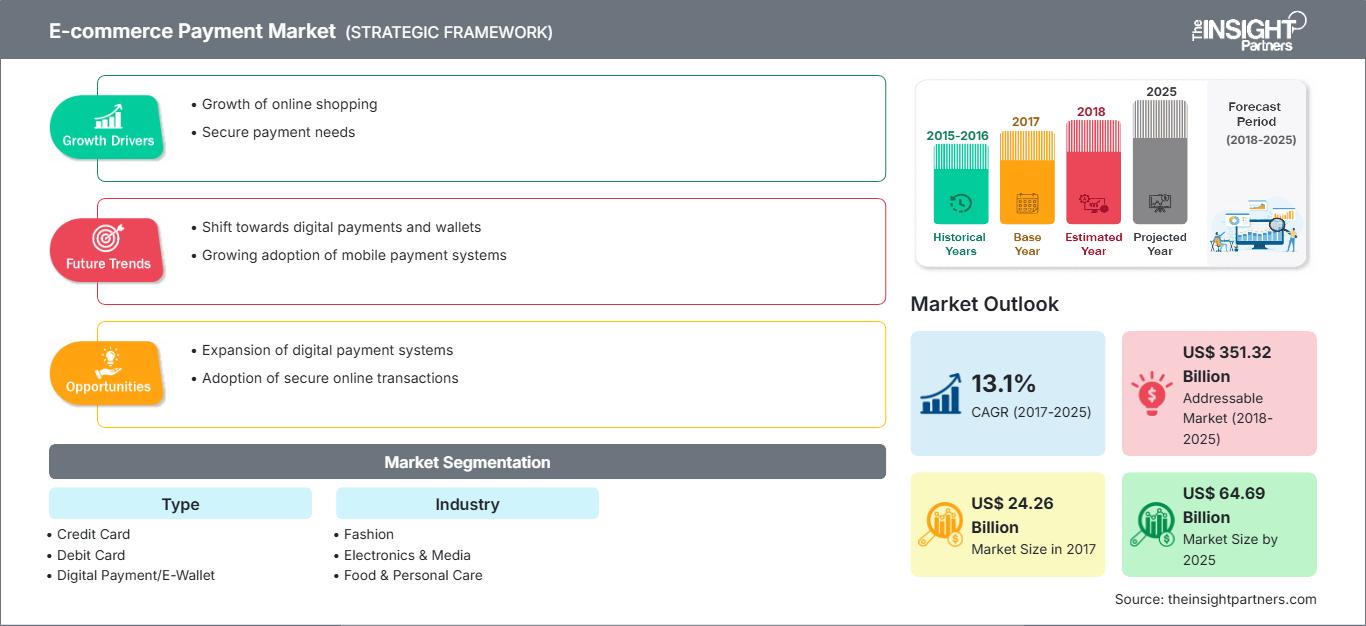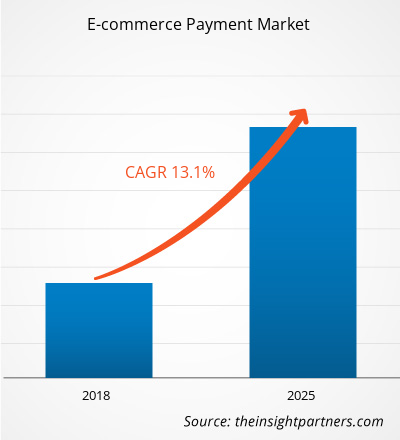Si prevede che il mercato globale dei pagamenti e-commerce crescerà da 24,26 miliardi di dollari nel 2017 a 64,69 miliardi di dollari entro il 2025, con un CAGR del 13,1% tra il 2018 e il 2025.
Il mercato dei pagamenti e-commerce sta registrando una crescita in tutto il mondo, con la crescente preferenza per i pagamenti online grazie alla disponibilità di diversi metodi di pagamento. Inoltre, la crescente diffusione degli smartphone e la disponibilità di Internet stanno stimolando la crescita del mercato dei pagamenti e-commerce. Inoltre, grazie al crescente numero di operatori bancari e alla digitalizzazione, si prevede che il mercato dei pagamenti e-commerce prospererà durante il periodo di previsione. Il rapporto si concentra su una segmentazione approfondita del mercato dei pagamenti e-commerce in base a tipologia, settore verticale e area geografica.
Approfondimenti di mercato
L'APAC è riconosciuta come la regione leader durante il periodo di previsione
La regione Asia-Pacifico comprende diversi paesi in via di sviluppo come Corea del Sud, India, Indonesia e Malesia, tra gli altri. Questi paesi stanno assistendo a una forte crescita demografica, con conseguente crescita del mercato dei pagamenti e-commerce. Il settore dell'e-commerce nella regione sta fiorendo con la crescente penetrazione di Internet e l'elevata adozione di smartphone e tablet. Inoltre, i governi delle economie emergenti stanno adottando iniziative per migliorare il sistema bancario, fornendo così una piattaforma migliore al settore dei pagamenti online. Recentemente, si è notato un cambiamento: i consumatori dell'APAC preferiscono pagare online tramite metodi di pagamento alternativi come portafogli elettronici, bonifici bancari e carte di credito e di debito. Si prevede che il crescente utilizzo di questi metodi di pagamento contribuirà in modo significativo alla crescita dei gateway di pagamento nel settore dell'e-commerce durante il periodo di previsione. Si prevede che questi fattori stimoleranno ulteriormente la domanda di pagamenti per l'e-commerce nella regione APAC.
Personalizza questo rapporto in base alle tue esigenze
Potrai personalizzare gratuitamente qualsiasi rapporto, comprese parti di questo rapporto, o analisi a livello di paese, pacchetto dati Excel, oltre a usufruire di grandi offerte e sconti per start-up e università
Mercato dei pagamenti per l'e-commerce: Approfondimenti strategici

-
Ottieni le principali tendenze chiave del mercato di questo rapporto.Questo campione GRATUITO includerà l'analisi dei dati, che vanno dalle tendenze di mercato alle stime e alle previsioni.
L'iniziativa di mercato è stata considerata la strategia più adottata nel mercato globale dei pagamenti e-commerce. Di seguito sono elencate alcune delle strategie recenti di alcuni degli attori del mercato dei pagamenti e-commerce:
2018: PayPal ha annunciato l'estensione del suo accordo di partnership con eBay. Grazie a questo accordo, eBay continuerà a promuovere e accettare PayPal Credit tramite la piattaforma di mercato. 2018: Alipay ha annunciato il lancio in 20 paesi europei alla fine di quest'anno. L'azienda ha firmato contratti con oltre 40 società di portafogli digitali e 100 banche in tutta Europa. 2018: Visa, Inc. ha annunciato l'estensione della sua partnership con PayPal al Canada, per accelerare l'implementazione di pagamenti mobili e digitali affidabili, sicuri e appropriati per commercianti e consumatori.
Approfondimenti regionali sul mercato dei pagamenti per l'e-commerce
Le tendenze e i fattori regionali che hanno influenzato il mercato dei pagamenti e-commerce durante il periodo di previsione sono stati ampiamente spiegati dagli analisti di The Insight Partners. Questa sezione analizza anche i segmenti e la geografia del mercato dei pagamenti e-commerce in Nord America, Europa, Asia-Pacifico, Medio Oriente e Africa, America Meridionale e Centrale.
Ambito del rapporto sul mercato dei pagamenti per l'e-commerce
| Attributo del rapporto | Dettagli |
|---|---|
| Dimensioni del mercato in 2017 | US$ 24.26 Billion |
| Dimensioni del mercato per 2025 | US$ 64.69 Billion |
| CAGR globale (2017 - 2025) | 13.1% |
| Dati storici | 2015-2016 |
| Periodo di previsione | 2018-2025 |
| Segmenti coperti |
By Tipo
|
| Regioni e paesi coperti |
Nord America
|
| Leader di mercato e profili aziendali chiave |
|
Densità degli operatori del mercato dei pagamenti e-commerce: comprendere il suo impatto sulle dinamiche aziendali
Il mercato dei pagamenti per l'e-commerce è in rapida crescita, trainato dalla crescente domanda degli utenti finali dovuta a fattori quali l'evoluzione delle preferenze dei consumatori, i progressi tecnologici e una maggiore consapevolezza dei vantaggi del prodotto. Con l'aumento della domanda, le aziende stanno ampliando la propria offerta, innovando per soddisfare le esigenze dei consumatori e sfruttando le tendenze emergenti, alimentando ulteriormente la crescita del mercato.

- Ottieni il Mercato dei pagamenti per l'e-commerce Panoramica dei principali attori chiave
Segmentazione del mercato globale dei pagamenti per l'e-commerce
Per tipo
- Carta di credito
- Carta di debito
- Pagamento digitale/Portafoglio elettronico
- Net banking
- Carte regalo
- Altro
Per settore
- Moda
- Elettronica e media
- Cibo e Cura della persona
- Mobili ed elettrodomestici
- Settore dei servizi
- Altri
Per area geografica
-
Nord America
- Stati Uniti
- Canada
- Messico
-
Europa
- Francia
- Germania
- Italia
- Spagna
- Regno Unito
- Resto d'Europa
-
Asia Pacifico (APAC)
- Australia
- Cina
- India
- Giappone
- Resto dell'APAC
-
Medio Oriente e Africa (MEA)
- Arabia Saudita Arabia
- Emirati Arabi Uniti
- Sudafrica
- Resto del Medio Oriente e Africa
-
Sud America (SAM)
- Brasile
- Resto del SAM
Profili aziendali
- PayPal Holdings, Inc.
- Amazon Payments, Inc.
- CCBill, LLC
- WePay Inc.
- Alipay
- Visa, Inc.
- MasterCard Incorporated
- Stripe Inc.
- American Express Company
- UnionPay International Co., Ltd.
- Analisi storica (2 anni), anno base, previsione (7 anni) con CAGR
- Analisi PEST e SWOT
- Valore/volume delle dimensioni del mercato - Globale, Regionale, Nazionale
- Industria e panorama competitivo
- Set di dati Excel
Report recenti
Testimonianze
Motivo dell'acquisto
- Processo decisionale informato
- Comprensione delle dinamiche di mercato
- Analisi competitiva
- Analisi dei clienti
- Previsioni di mercato
- Mitigazione del rischio
- Pianificazione strategica
- Giustificazione degli investimenti
- Identificazione dei mercati emergenti
- Miglioramento delle strategie di marketing
- Aumento dell'efficienza operativa
- Allineamento alle tendenze normative






















 Ottieni un campione gratuito per - Mercato dei pagamenti per l'e-commerce
Ottieni un campione gratuito per - Mercato dei pagamenti per l'e-commerce